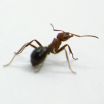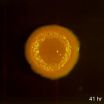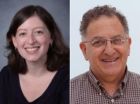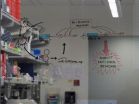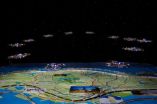(Press-News.org) COLUMBUS, Ohio—High hopes may help move a rubber tree plant (as the old song goes), but the real secret to the ant's legendary strength may lie in its tiny neck joint.
In the Journal of Biomechanics, researchers report that the neck joint of a common American field ant can withstand pressures up to 5,000 times the ant's weight.
"Ants are impressive mechanical systems—astounding, really," said Carlos Castro, assistant professor of mechanical and aerospace engineering at The Ohio State University. "Before we started, we made a somewhat conservative estimate that they might withstand 1,000 times their weight, and it turned out to be much more."
The engineers are studying whether similar joints might enable future robots to mimic the ant's weight-lifting ability on earth and in space.
Other researchers have long observed ants in the field and guessed that they could hoist a hundred times their body weight or more, judging by the payload of leaves or prey that they carried. Castro and his colleagues took a different approach.
They took the ants apart.
"As you would in any engineering system, if you want to understand how something works, you take it apart," he said. "That may sound kind of cruel in this case, but we did anesthetize them first."
The engineers examined the Allegheny mound ant (Formica exsectoides) as if it were a device that they wanted to reverse-engineer: they tested its moving parts and the materials it is made of.
They chose this particular species because it's common in the eastern United States and could easily be obtained from the university insectary. It's an average field ant that is not particularly known for it's lifting ability.
They imaged ants with electron microscopy and X-rayed them with micro-computed tomography (micro-CT) machines. They placed the ants in a refrigerator to anesthetize them, then glued them face-down in a specially designed centrifuge to measure the force necessary to deform the neck and eventually rupture the head from the body.
The centrifuge worked on the same principle as a common carnival ride called "the rotor." In the rotor, a circular room spins until centrifugal force pins people to the wall and the floor drops out. In the case of the ants, their heads were glued in place on the floor of the centrifuge, so that as it spun, the ants' bodies would be pulled outward until their necks ruptured.
The centrifuge spun up to hundreds of rotations per second, each increase in speed exerting more outward force on the ant. At forces corresponding to 350 times the ants' body weight, the neck joint began to stretch and the body lengthened. The ants' necks ruptured at forces of 3,400-5,000 times their average body weight.
Micro-CT scans revealed the soft tissue structure of the neck and its connection to the hard exoskeleton of the head and body. Electron microscopy images revealed that each part of the head-neck-chest joint was covered in a different texture, with structures that looked like bumps or hairs extending from different locations.
"Other insects have similar micro-scale structures, and we think that they might play some kind of mechanical role," Castro said. "They might regulate the way that the soft tissue and hard exoskeleton come together, to minimize stress and optimize mechanical function. They might create friction, or brace one moving part against the other."
Another key feature of the design seems to be the interface between the soft material of the neck and the hard material of the head. Such transitions usually create large stress concentrations, but ants have a graded and gradual transition between materials that gives enhanced performance—another design feature that could prove useful in man-made designs.
"Now that we understand the limits of what this particular ant can withstand and how it behaves mechanically when it's carrying a load, we want to understand how it moves. How does it hold its head? What changes when the ant carries loads in different directions?"
One day, this research could lead to micro-sized robots that combine soft and hard parts, as the ant's body does. Much work in robotics today involves assembling small, autonomous devices that can work together.
But a difficult problem will emerge if the researchers try to create large robots based on the same design, Castro explained.
Ants are super-strong on a small scale because their bodies are so light. Inside their hard exoskeletons, their muscles don't have to provide much support, so they are free to apply all their strength to lifting other objects. Humans, in contrast, carry comparatively heavy loads due to our body weight. With our muscles supporting our body weight, we don't have as much strength left over to lift other objects.
On a human-sized scale, though, ants are overcome by basic physics. Their weight increases with their overall volume (dimensions cubed), while the strength of their muscles only increases with surface area (dimensions squared). So a human-sized ant, were it to exist outside of a horror movie, would likely not be so successful in carrying extreme loads at a human scale.
A large robot based on that design might be able to carry and tow cargo in microgravity, though, so it's possible that we may one day employ giant robot ants in space, "or, at least, something inspired by ants," Castro said.
Meanwhile, the engineers will study the ant's muscles closely—perhaps using magnetic resonance imaging. Computer simulations will also help answer the question of how to scale up similar structures.
Blaine Lilly, associate professor of mechanical and aerospace engineering, began this work with former student Vienny Nguyen. Nguyen earned her master's degree with this project, and is now a robotics engineer at Johnson Space Center, where she is helping to design NASA's Valkyrie robot for the DARPA Robotics Challenge. Ohio State undergraduate student Hiromi Tsuda recently joined Castro's team, and she is analyzing the ant's surface textures in more detail. Castro and Lilly have also begun collaborations with Noriko Katsube, also a professor of mechanical and aerospace engineering, and an expert in mechanical modeling of biomaterials.
INFORMATION:
Funding for this work came from Ohio State's Institute for Materials Research and Nguyen's National Science Foundation graduate research fellowship. Computing resources were provided by the Ohio Supercomputer Center; structural modeling software support by Simpleware Ltd.; and micro-CT by the laboratory of Richard Hart, professor and chair of the Department of Biomedical Engineering at Ohio State.
Contact: Carlos Castro, (614) 292-2662; Castro.39@osu.edu
Written by Pam Frost Gorder, (614) 292-9475; Gorder.1@osu.edu
Editor's note: images are available from Pam Frost Gorder.
With their amazing necks, ants don't need 'high hopes' to do heavy lifting
Ants can lift up to 5,000 times their own body weight, new study suggests
2014-02-11
ELSE PRESS RELEASES FROM THIS DATE:
Chips that listen to bacteria
2014-02-11
VIDEO:
The development of colony biofilms by Pseudomonas aeruginosa is affected by redox-active compounds called phenazines. A phenazine-null mutant forms a hyperwrinkled colony with prominent spokes, while wild-type colonies are more...
Click here for more information.
New York, NY—February 10, 2014—In a study published today in Nature Communications, a research team led by Ken Shepard, professor of electrical engineering and biomedical engineering at Columbia Engineering, ...
Manga comics may help promote fruit consumption among youth
2014-02-11
AUDIO:
May May Leung, Ph.D., R.D., discusses how a recent pilot study in Brooklyn, N.Y., with minority students found that exposure to manga comics (Japanese comic art) promoting fruit intake significantly...
Click here for more information.
PHILADELPHIA, PA, February 10, 2014 – A recent pilot study in Brooklyn, New York, with minority students found that exposure to Manga comics (Japanese comic art) promoting fruit intake significantly improved healthy snack selection. As ...
Political values influence people's response to health disparities messages
2014-02-11
PHILADELPHIA (February 10, 2014) – Policymakers and advocates discussing health disparities in the United States would be wise to consider the political affiliation of their audience, suggests a new study published in the Journal of Health Communication: International Perspectives (2014).
"Understanding Public Resistance to Messages about Health Disparities" was written by Sarah E. Gollust, University of Minnesota School of Public Health; and Joseph N. Cappella, Annenberg School for Communication, University of Pennsylvania. The study examines how political ...
TGen study uncovers possible genetic markers in breast cancer that spreads to the brain
2014-02-11
PHOENIX, Ariz. — Feb. 10, 2014 — The Translational Genomics Research Institute (TGen) has uncovered possible genetic origins of breast cancer that spreads to the brain, according to a first-of-its-kind study published in the scientific journal PLOS ONE.
The compendium of genetic targets uncovered by TGen now can be used to identify potential new methods of diagnosis and new drug therapies for the estimated 45,000 patients in the U.S. each year whose cancer spreads from the breast to the brain.
The 3-year study is significant since these patients currently have few treatments ...
New advance in 3-D printing and tissue engineering technology
2014-02-11
Boston, MA – Researchers at Brigham and Women's Hospital (BWH) and Carnegie Mellon University have introduced a unique micro-robotic technique to assemble the components of complex materials, the foundation of tissue engineering and 3D printing.
Described in the Jan. 28, 2014, issue of Nature Communications, the research was conducted by Savas Tasoglu, PhD, MS, research fellow in the BWH Division of Renal Medicine, and Utkan Demirci, PhD, MS, associate professor of Medicine in the Division of Biomedical Engineering, part of the BWH Department of Medicine, in collaboration ...
Breast cancer drug fights fungal disease
2014-02-11
Tamoxifen, a drug currently used to treat breast cancer, also kills a fungus that causes a deadly brain infection in immunocompromised patients. The findings, which could lead to new treatments for a disease that kills more HIV/AIDS patients than tuberculosis, appear in mBio®, the online open-access journal of the American Society for Microbiology (ASM.)
"This work sets the stage for additional animal studies to see if tamoxifen can be used as a drug in people and will allow us to design new drugs related to tamoxifen that are better antifungals," says Damian Krysan ...
Study shows drop in crime rates is less where Wal-Mart builds
2014-02-10
Communities across the United States experienced an unprecedented decline in crime in the 1990s. But for counties where Wal-Mart built stores, the decline wasn't nearly as dramatic.
"The crime decline was stunted in counties where Wal-Mart expanded in the 1990s," says Scott Wolfe, assistant professor of criminology and criminal justice at the University of South Carolina and lead author of a new study. "If the corporation built a new store, there were 17 additional property crimes and 2 additional violent crimes for every 10,000 persons in a county."
The study, titled ...
Newly found tactics in offense-defense struggle with hepatitis C virus
2014-02-10
The hepatitis C virus (HCV) has a previously unrecognized tactic to outwit antiviral responses and sustain a long-term infection. It also turns out that some people are genetically equipped with a strong countermeasure to the virus' attempt to weaken the attack on it.
The details of these findings suggest potential targets for treating HCV, according to a research team led by Dr. Ram Savan, assistant professor of immunology at the University of Washington. The study was published in Nature Immunology.
HCV infects more than 150 million of the world's people. The ...
NTU showcases expertise in UAV technology at Singapore Airshow 2014
2014-02-10
Nanyang Technological University (NTU) will be showcasing its latest R&D expertise in Unmanned Aerial Vehicle (UAV) technology at the Singapore Airshow, one of the most important aerospace and defence exhibitions in the world, held from 11 to 16 February.
Visitors to the Singapore Airshow will be able to see 12 drones, programmed by NTU scientists and researchers, flying in formation within inches of each other and executing complex indoor aerial manoeuvres.
In addition to the formation air-show by 12 quad-rotor Unmanned Aerial Vehicles complete with strobe lights ...
Australians discover oldest star
2014-02-10
A team led by astronomers at The Australian National University has discovered the oldest known star in the Universe, which formed shortly after the Big Bang 13.7 billion years ago.
The discovery has allowed astronomers for the first time to study the chemistry of the first stars, giving scientists a clearer idea of what the Universe was like in its infancy.
"This is the first time that we've been able to unambiguously say that we've found the chemical fingerprint of a first star," said lead researcher, Dr Stefan Keller of the ANU Research School of Astronomy and Astrophysics.
"This ...
LAST 30 PRESS RELEASES:
Tracing the quick synthesis of an industrially important catalyst
New software sheds light on cancer’s hidden genetic networks
UT Health San Antonio awarded $3 million in CPRIT grants to bolster cancer research and prevention efforts in South Texas
Third symposium spotlights global challenge of new contaminants in China’s fight against pollution
From straw to soil harmony: International team reveals how biochar supercharges carbon-smart farming
Myeloma: How AI is redrawing the map of cancer care
Manhattan E. Charurat, Ph.D., MHS invested as the Homer and Martha Gudelsky Distinguished Professor in Medicine at the University of Maryland School of Medicine
Insilico Medicine’s Pharma.AI Q4 Winter Launch Recap: Revolutionizing drug discovery with cutting-edge AI innovations, accelerating the path to pharmaceutical superintelligence
Nanoplastics have diet-dependent impacts on digestive system health
Brain neuron death occurs throughout life and increases with age, a natural human protein drug may halt neuron death in Alzheimer’s disease
SPIE and CLP announce the recipients of the 2025 Advanced Photonics Young Innovator Award
Lessons from the Caldor Fire’s Christmas Valley ‘Miracle’
Ant societies rose by trading individual protection for collective power
Research reveals how ancient viral DNA shapes early embryonic development
A molecular gatekeeper that controls protein synthesis
New ‘cloaking device’ concept to shield sensitive tech from magnetic fields
Researchers show impact of mountain building and climate change on alpine biodiversity
Study models the transition from Neanderthals to modern humans in Europe
University of Phoenix College of Doctoral Studies releases white paper on AI-driven skilling to reduce burnout and restore worker autonomy
AIs fail at the game of visual “telephone”
The levers for a sustainable food system
Potential changes in US homelessness by ending federal support for housing first programs
Vulnerability of large language models to prompt injection when providing medical advice
Researchers develop new system for high-energy-density, long-life, multi-electron transfer bromine-based flow batteries
Ending federal support for housing first programs could increase U.S. homelessness by 5% in one year, new JAMA study finds
New research uncovers molecular ‘safety switch’ shielding cancers from immune attack
Bacteria resisting viral infection can still sink carbon to ocean floor
Younger biological age may increase depression risk in older women during COVID-19
Bharat Innovates 2026 National Basecamp Showcases India’s Most Promising Deep-Tech Ventures
Here’s what determines whether your income level rises or falls
[Press-News.org] With their amazing necks, ants don't need 'high hopes' to do heavy liftingAnts can lift up to 5,000 times their own body weight, new study suggests


